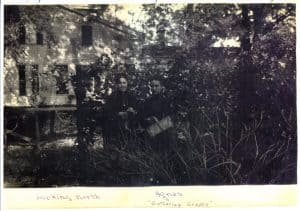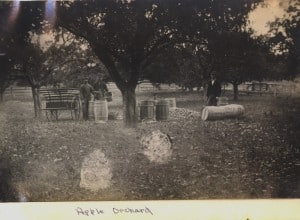Kitchen Gardens
By Mel Oles, Visitor Services and Program Manager at Rose Hill Mansion and Johnston House
Currently I’m researching kitchen gardens, gardens, and farming in the 19th century for projects at Rose Hill. When I think of farming in the past, I often romanticize it. I imagine people going to their kitchen gardens to pick fresh herbs and vegetables or get milk from their cow in a green pasture. However, food during the period could be dangerous and even kill you.
In the 19th century, food safety practices were not as advanced as they are today. There were limited regulations and oversight, which led to various food safety issues. Food was also transitioning into industrial production, especially in cities. City dwellers were not going out to the local farm to purchase their food. They were buying manufactured food from their local shop.
The kitchen garden played an essential role in providing households with fresh, homegrown produce. These gardens were carefully cultivated spaces where fruits, vegetables, herbs, and flowers were grown to support daily meals. Most kitchen gardens were born out of necessity, as reliable access to fresh produce was limited in many areas. Families relied on these gardens to supplement their meals. There were also seasonal crops. Today we can go to our local grocery store and buy strawberries in the month of January.
We also have safe milk products. In the 19th century “milk” might contain formaldehyde (most often used to embalm dead bodies). By some estimates, in New York City alone, thousands of children were killed by “embalmed milk” every year. Milk was also often watered down to create larger profits. If the milk looked watered down chalk and other substances were probably used to thicken it.
Many foods were produced locally and consumed fresh, reducing the risk of contamination during transportation. However, methods for preserving food were not as developed, leading to spoilage and the growth of harmful bacteria. Today we have food regulations and labels to help protect us.
While the Swan family (who lived on the property from 1850 to 1890) had financial resources to purchase healthier food, they also had a kitchen garden, orchard, and large farm. They were able to live the farm-to-table lifestyle we often imagine.
The current kitchen garden project and other landscape projects are still in the research stage. The layout and design of the kitchen garden will be important. Depending on the available space and individual preferences, the layout of the kitchen garden varied. They often featured geometric patterns, with neatly organized beds and pathways. Fences or hedges provided protection from animals and served as boundaries, while water sources were strategically placed for irrigation. A wide range of crops were typically grown in kitchen gardens. In addition to common vegetables and fruits, many gardens featured herbs for cooking or medicine. Our plan at Rose Hill is to create an experience that will allow visitors to go back in time to the 19th century.
To explore the history of food and beverages in Geneva, view the exhibit Eat, Drink and Be Merry.



We will look forward to the kitchen garden. Thank you for all the improvements that are being made.
Mel, very interesting and thought provoking piece. Although it seems obvious now, I never gave any thought to how dangerous the food supply could be. Both sets of my grandparents had huge kitchen gardens that they relied on for much of their lives. Occasionally, if the harvest was bountiful, we were allowed to set up a stand and sell the vegetables. Boy, was that fun! Thanks for bringing that memory to mind.